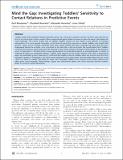Mind the Gap: Investigating Toddlers’ Sensitivity to Contact Relations in Predictive Events
Author(s)
Muentener, Paul Jason; Bonawitz, Elizabeth; Horowitz, Alexandra; Schulz, Laura E.
DownloadSchulz-2012-Mind the gap.pdf (689.3Kb)
PUBLISHER_CC
Publisher with Creative Commons License
Creative Commons Attribution
Terms of use
Metadata
Show full item recordAbstract
Toddlers readily learn predictive relations between events (e.g., that event A predicts event B). However, they intervene on A to try to cause B only in a few contexts: When a dispositional agent initiates the event or when the event is described with causal language. The current studies look at whether toddlers’ failures are due merely to the difficulty of initiating interventions or to more general constraints on the kinds of events they represent as causal. Toddlers saw a block slide towards a base, but an occluder prevented them from seeing whether the block contacted the base; after the block disappeared behind the occluder, a toy connected to the base did or did not activate. We hypothesized that if toddlers construed the events as causal, they would be sensitive to the contact relations between the participants in the predictive event. In Experiment 1, the block either moved spontaneously (no dispositional agent) or emerged already in motion (a dispositional agent was potentially present). Toddlers were sensitive to the contact relations only when a dispositional agent was potentially present. Experiment 2 confirmed that toddlers inferred a hidden agent was present when the block emerged in motion. In Experiment 3, the block moved spontaneously, but the events were described either with non-causal (“here’s my block”) or causal (“the block can make it go”) language. Toddlers were sensitive to the contact relations only when given causal language. These findings suggest that dispositional agency and causal language facilitate toddlers’ ability to represent causal relationships.
Date issued
2012-04Department
Massachusetts Institute of Technology. Department of Brain and Cognitive SciencesJournal
PLoS ONE
Publisher
Public Library of Science
Citation
Muentener, Paul et al. “Mind the Gap: Investigating Toddlers’ Sensitivity to Contact Relations in Predictive Events.” Ed. Manos Tsakiris. PLoS ONE 7.4 (2012): e34061. Web.
Version: Final published version
ISSN
1932-6203